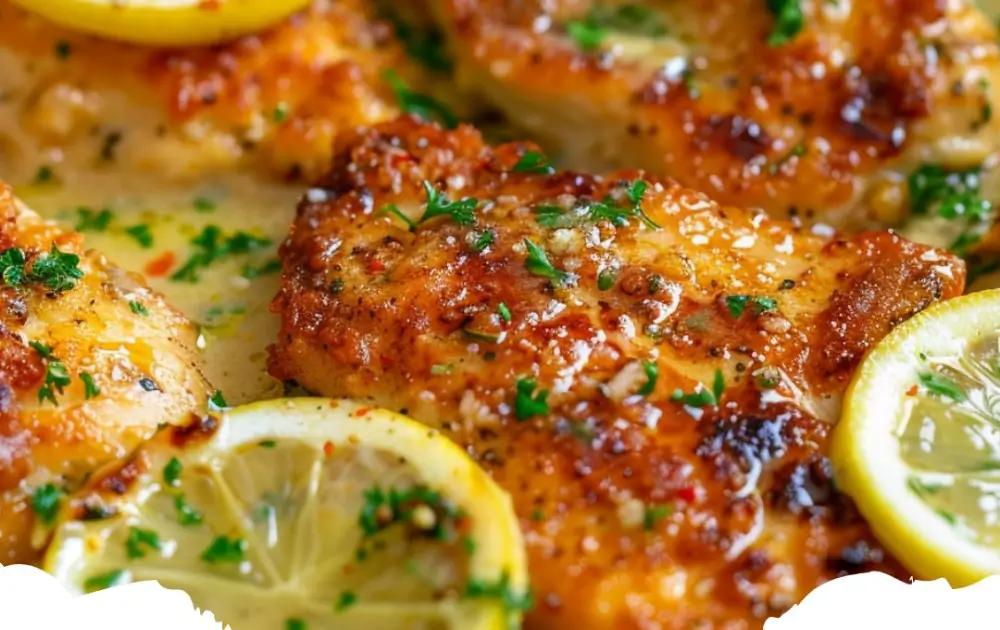Chicken Francese, also known as Chicken Francaise, is a stunning dish that combines the juiciness of chicken cutlets with the rich, lemony sauce of Italian-American cuisine. This dish is celebrated for its golden, lightly breaded chicken that’s pan-fried to perfection and then draped in a vibrant lemon-butter sauce. It’s a favorite in many households for its elegant presentation and the delightful contrast of flavors.
Print
- Total Time: 40 minutes
- Yield: Serves 4
- Diet: Gluten Free
Description
Chicken Francese is an exquisite Italian-American dish featuring tender chicken cutlets coated in flour and egg, pan-fried to golden perfection, and served with a vibrant lemon-butter sauce. This dish combines the simplicity of its ingredients with the richness of flavors, creating a delightful meal that’s both comforting and elegant.
Ingredients
2 chicken breasts
1/2 cup plain flour
2 eggs
1 handful of fresh parsley
50g (2oz) Parmesan cheese
1 cup white wine
1 cup chicken stock
1 garlic clove
4 tbsp olive oil
4 tbsp butter
1/2 lemon
Salt and pepper
Instructions
Step 1
Crack the eggs into a large dish. Season with salt and pepper, lightly beat.
Step 2
Finely chop the parsley, keeping some for garnish. Add half to the egg mixture.
Step 3
Grate the Parmesan cheese finely, add to the egg mixture. Mix well and set aside.
Step 4
Remove chicken skin (if any) and butterfly cut the breasts. Flatten the thicker side using cling film and a meat mallet.
Step 5
Prepare white wine and chicken stock.
Step 6
Spread the plain flour on a plate.
Step 7
Peel and press garlic or chop finely.
Step 8
In a frying pan over moderate heat, add olive oil and half of the butter.
Step 9
Coat chicken in flour, shake off excess.
Step 10
Dip chicken in egg wash, ensuring full coverage. Place in hot oil.
Step 11
Cook chicken for approximately 4 minutes on each side, until browned. Transfer to a plate and rest.
Step 12
In the same pan over high heat, add white wine, chicken stock, crushed garlic, and lemon juice. Reduce for 2 minutes.
Step 13
Add remaining parsley and butter. Mix until butter is melted over low heat.
Step 14
Return chicken to the sauce, heating for no more than 30 seconds.
Step 15
Serve chicken on warm plates, garnished with parsley sprigs. Enjoy your Chicken Francese! ![]()
Notes
- Ensure chicken breasts are evenly pounded to ensure uniform cooking.
- Adjust the lemon juice and broth ratio according to taste for a more or less tangy sauce.
- Can be served over pasta or with a side of vegetables for a complete meal.
- Can be adapted for gluten-free diets by using gluten-free flour.
- Prep Time: 15 minutes
- Cook Time: 25 minutes
- Category: Main Course
- Method: Pan-Frying
- Cuisine: Italian-American
Nutrition
- Calories: 350
- Sugar: 1g
- Sodium: 200mg
- Fat: 18g
- Saturated Fat: 8g
- Carbohydrates: 10g
- Fiber: 0.5g
- Protein: 26g
- Cholesterol: 150mg

FAQs
Can Chicken Francese be made ahead of time?
Yes, you can prepare Chicken Francese in advance. Cook the chicken and sauce separately, then refrigerate. When ready to serve, gently reheat the chicken in the oven and warm the sauce on the stove before combining them. This method helps maintain the dish’s quality.
What’s the best way to achieve a smooth sauce for Chicken Francese?
For a smooth sauce, ensure to whisk continuously while gradually adding the broth and lemon juice to the pan residues. If lumps appear, straining the sauce through a fine sieve can remove them, resulting in a velvety consistency.
How can I thicken the sauce if it’s too runny?
If the sauce for Chicken Francese is too runny, a slurry made from a teaspoon of cornstarch and a tablespoon of water mixed in can thicken it. Add this mixture to the simmering sauce, stirring constantly until it reaches the desired thickness.
Is it possible to use boneless chicken thighs instead of breasts for Chicken Francese?
Yes, boneless chicken thighs can be used as an alternative to chicken breasts in Chicken Francese. They might require a slightly longer cooking time due to their higher fat content but will result in a juicier and more flavorful dish.
Can Chicken Francese be frozen for later use?
While you can freeze Chicken Francese, it’s best enjoyed fresh. If you must freeze it, do so without the sauce to prevent the chicken from becoming soggy. Freeze the sauce separately and combine after both components have been thawed and reheated.
Selecting the Right Ingredients
To ensure the success of Chicken Francese, start with thin chicken breast cutlets. If the chicken breasts are thick, butterfly them or pound them thin for even cooking. Fresh lemons are non-negotiable for their zest and juice, which are key to the sauce’s bright flavor. High-quality butter and a dry white wine, such as Pinot Grigio, contribute to the richness of the sauce, making the dish truly memorable.
Preparing the Chicken Cutlets
Begin by dredging the chicken cutlets in flour seasoned with salt and pepper, then dip them into beaten eggs. This process not only adds flavor but also creates a delicate coating that turns beautifully golden when pan-fried. Ensure your skillet is at the right temperature with a mix of olive oil and butter before adding the chicken, to achieve that perfect sear without burning.
Creating the Lemon-Butter Sauce
After frying the chicken to a golden brown, set the cutlets aside and focus on the sauce. In the same pan, add a bit more butter, fresh lemon juice, white wine, and chicken broth. Let the sauce simmer and reduce slightly, scraping up any browned bits from the pan for extra flavor. Finishing the sauce with a touch of fresh parsley adds a pop of color and freshness.
Assembling and Serving Chicken Francese
Once the sauce has thickened to your liking, return the chicken cutlets to the pan, spooning the sauce over them to reheat and coat them thoroughly. Serve Chicken Francese hot, garnished with lemon slices and a sprinkle of chopped parsley for an elegant presentation. This dish pairs wonderfully with light pasta, steamed vegetables, or a simple salad, making it versatile for any dining occasion.
Customizing Your Chicken Francese
Chicken Francese is a dish that welcomes customization. For those who prefer a creamier sauce, a splash of heavy cream can be added at the end of cooking. If you’re looking to add a bit more body to the sauce, capers or artichoke hearts can introduce new textures and flavors that complement the chicken and lemon beautifully.

Chicken Francese stands as a testament to the elegance and simplicity of Italian-American cooking. With its tender chicken, golden crust, and zesty sauce, it’s a dish that promises to delight the palate and elevate any meal to a special occasion. Whether enjoyed in a cozy home kitchen or served at a festive gathering, Chicken Francese is a culinary experience that’s both comforting and sophisticated.



